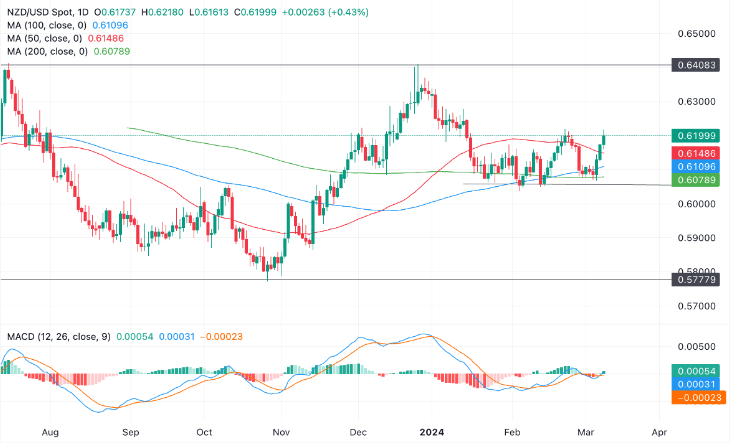- The New Zealand Dollar strengthens against the US Dollar in the aftermath of the US employment data release.
- While US Nonfarm Payrolls exceeded expectations in February, the positive impact was mitigated by disappointing wage and unemployment figures.
- Hourly Earnings fell short of expectations, and the Unemployment Rate unexpectedly increased, indicating potential weaknesses in the underlying labor market.
On Friday, the New Zealand Dollar experiences an upswing against the US Dollar, propelled by the US Nonfarm Payrolls data hinting at disinflationary tendencies. The release suggests a potential acceleration in the timeline for the Federal Reserve’s anticipated first interest rate cut.
During the US session, NZD/USD, representing the amount of US Dollars one New Zealand Dollar can purchase, reaches a daily high of 0.6218 in response to the Bureau of Labor Statistics (BLS) report. The prospect of an earlier Fed rate cut is viewed negatively for the US Dollar, as lower rates tend to attract fewer foreign capital inflows.
New Zealand Dollar prints new high after Nonfarm Payrolls
While the headline Nonfarm Payrolls (NFP) figure indicated the addition of 275,000 jobs to the economy in February, surpassing the expected 200,000, other metrics in the Bureau of Labor Statistics (BLS) report highlighted vulnerabilities in the labor market.
Average Hourly Earnings, a crucial inflation indicator, recorded a lower-than-anticipated year-on-year increase of 4.3% and a monthly rise of 0.1%, both falling below the predicted 4.4% and 0.3%. Concurrently, the Unemployment Rate climbed to 3.9%, surpassing the anticipated 3.7% projection.
This data implies diminished inflationary pressure stemming from wage growth and a higher-than-expected unemployment rate, potentially prompting the Federal Reserve to expedite interest rate cuts earlier in the year. Lower interest rates, in turn, may adversely impact the US Dollar by reducing foreign capital inflows.
New Zealand Dollar supported by Brighter outlook for China
The New Zealand Dollar (NZD) receives additional support following the release of trade data from its primary export partner, China, on Thursday.
Chinese Trade Balance figures unexpectedly reveal a surge in the country’s trade surplus, reaching $125.16 billion in February, as reported by the General Administration of Customs for the People’s Republic of China. This surpasses economists’ projections, with expectations set at $103.70 billion, compared to the lower figure of $75.34 billion in the previous month of January.
The heightened trade surplus signifies economic robustness, indicating increased prosperity and fostering greater demand for New Zealand exports, particularly milk and dairy products. This surge in demand is anticipated to drive an uptick in the demand for the New Zealand Dollar.
Technical analysis: NZD/USD rising in a range
NZD/USD is currently situated in the midst of a prolonged sideways consolidation phase that has endured for more than a year. The long-term trend remains unclear, indicating a limited overall directional bias.

The upper boundary of the range is situated at 0.6400, and only a breakthrough above this level would signify the emergence of a bullish trend. On the contrary, the lower limit, amidst the various fluctuations, appears near 0.5800. A price drop below this threshold would be required to shift the trend to bearish.
Since Wednesday, the price has rebounded from the support level formed by the convergence of the 100-day and 200-day Simple Moving Averages (SMA) around 0.6090. Despite the robust recovery, it is premature to conclude that a short-term uptrend is underway.
A potential development on Friday (today), if closing as a green up day, could form a bullish Three White Soldier Japanese candlestick pattern. This suggests an increased likelihood of a bullish continuation. However, given the predominantly sideways nature of the pair, reliance on such a pattern may be tempered unless accompanied by a substantial shift in fundamental factors.
